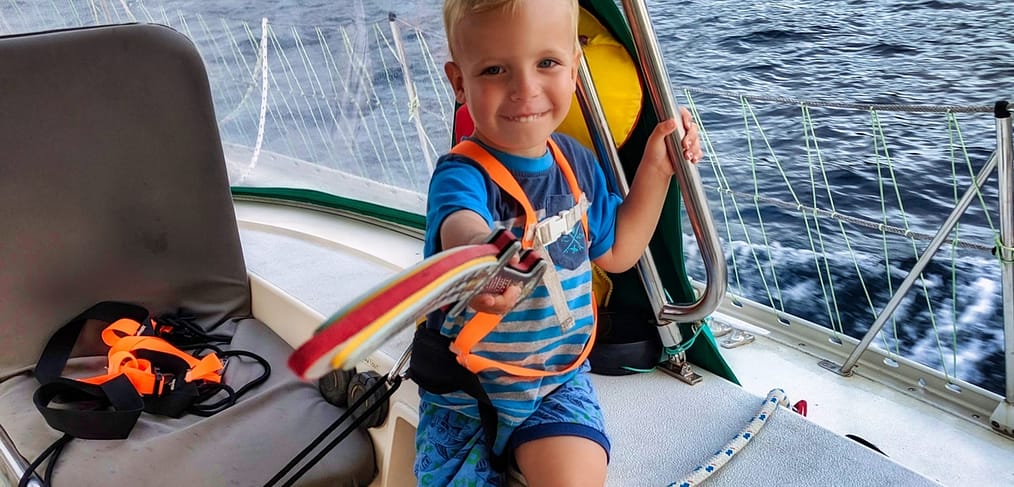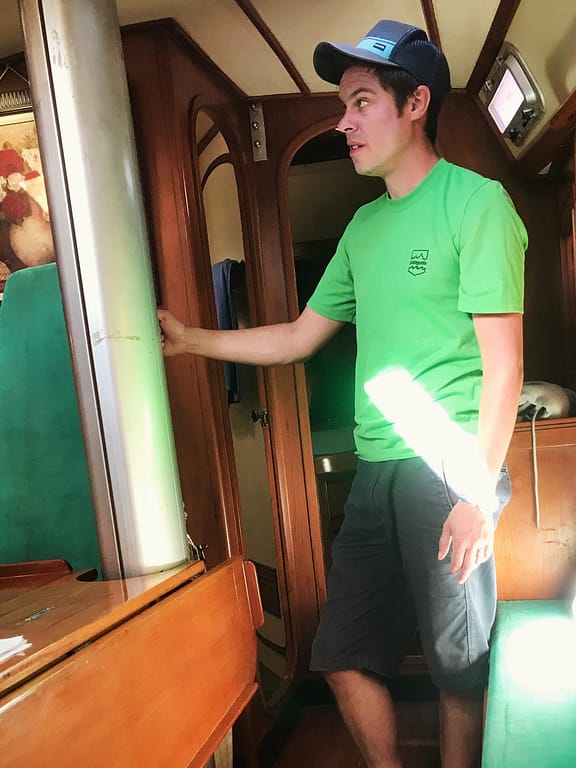
The Great 11 Years War
“One day Cass, we’ll have a dry boat”, I say when going down inside Sputnik. That was 8 years ago, and I was yet again welcomed by pools of water over the floor. A mix of rain water coming from the mast, condensation from the cold weather in Quebec and millions of undiscovered leaks. I was set to have a dry boat. A boat without water in the bilge. Which isn’t a small feat, given the fact that Sputnik was 27 years old. And that it was, you know, a boat.
I had spent the last 2 years chasing leaks and water intrusion everywhere. The bilge and walls were a collection of multi-colored lines of crayola, my latest brilliant idea to see where water was dripping down. Green water in the bilge meant it was coming from the galley, orange from the engine room, and so on. Brillant on paper but unfortunately, the bilge was always ending up brown..
“That doesn’t exist Sam. Nobody has a dry boat. Except Martin!”. Martin had been our sailing teacher. We had bounded during our classes and had sailed on his boat for 2 years before managing to buy our pride and joy – Sputnik: a W.D. Shock Santana 30. Martin had owned his boat, Ultimo, for 10 years by that time. A longer ownership, much more maintenance experience and a bigger budget meant that Ultimo was to our eye the Holy Grail; a boat where all the screws were aligned, where not a single block was squeaking and where the toilet paper was stored in the bilge.
We owned Sputnik for 9 years. We had glorious trips with him and memories that we’ll cherish for ever. But for 9 years, I spent more time at the dock working on him than sailing. Pools of water were getting smaller and smaller. I managed to eleminate most of them. But 9 years later, there was still water in the bilge.
When we sold Sputnik and started looking for the boat that would bring us over the horizons, the list of criteria was pretty long. And I had a hidden one from Cass; a deck-step mast. I was convinced that most of the water still coming inside Sputnik was from the mast, since the mast was going through the deck and was stepped on the keel, while Martin’s boat, Ultimo, was deck-step.

We searched for a long time before finding Pablo and by that time, we had to let go of most of our criteria. But by sheer luck, Pablo was deck-stepped! In my eye, it was the perfect boat! There was only one problem. Gallons of water in the bilge…
“It must be the 35 years old plumbing” I was telling Cass in the plane on our way back home. I’m sure of it!
We bought Pablo. And even though priority-wise it made little sense in the grand scheme of things, one of the main projects of the initial refit included redoing all of the plumbing. To be fair, 35 years of ownership had created a maze of hoses with failing hose-clamps and mystery ball-valves. So starting from scratch was actually simpler than trying to fix everything. I had learnt a lot regarding water intrusion with Sputnik, so I didn’t stop there. I started rebeding most of the deck hardwares. Then ripped the portlights that were definitely taking on water and rebeded those as well. I inspected all the bilges and since everything was dry (probably a first time in years), I cleaned them with litters of acetone and painted everything bright white. Happy day!
Feeling pretty happy with myself, we splashed after 3 months of hard work, It was time for us to start to know Pablo, our new Moody 47, our new home.
My confidence was however short lived. That very night, I was looking at water in the bilge. Just enough to be really annoyed. The next evening, after our first sail with Pablo, I was reunited with an old friend. My trusty shop-vac that had emptied bilge water for 9 years on Sputnik was yet at it again, pumping out gallons and gallons of water from the bilge. Cass looked at me with all the love in the world. “We’ll succeed this time Sam. Don’t despair!”
And so it began again. The grand ritual at the end of every sail: vacuuming the bilges and lifting up floorboards trying to feel where the water was coming from. And as we were making our way down the Carribeans, the sinking feeling we wouldn’t succeed was growing. By the time we reached Grenada, I gave up. After all, the boat is 47′ long and 35 years old. Water was salted, so we knew the plumbing wasn’t leaking. I started to blame the stuffing box, the place where the shaft enters the hull. It needs to be water lubricated to cope with the high friction of a spinning shaft, so their design to drip in the bilge.
On our way from Bonaire to Panama, water was slushing so much in the bilge that we had to resort to use the emergency manual bilge pumps. It was the first time it was so bad, and altough we wouldn’t sink, it shook us enough to bring back the topic of bilge water on top of the priority list. After all, we were planning to cross the biggest ocean on earth.. But where to start? We had consistently failed for 14 months now!
And Christmas came! A fitting connecting our holding tank to the toilet broke off on Christmas morning, emptying 20 gallons of horribly disgusting water in the bilge. It took us 6 truly smelly hours to clean everything but by the end of it, I had seen something. A revelation really. A half teaspoon of water on a rib of the hull, just below a thru-hull that is inches over the waterline. Could that be it? It would explain why we take on so much water when sailing; the thru-hull goes under the waterline when heeling..

The next sail prooved me right. While heeling on port tack, water was pooring in! A week later, we were on the hard again to fix a grinding noise when motoring – our cutlass bearing was dead and cutting away our shaft! We had to remove the shaft to access the bearing, which meant I could remove the stuffing box at the same time.. We impulsively decided to change it for a dripless shaft seal. Dripless being the key word. I fixed the problematic thru-hull and for the first time in more than a year, I was filled with hopes again. Pablo would be dry after all!
Except it wasn’t. But the problem was much – much! – smaller! Yet, the shop-vac was still in use. “In our family, we try!” is the motto we keep repeating the kids. So Mateo reminded it to me that night, and I kept going at the problem.
Fast forwards a couple of weeks, just the time needed to find and fix 1 broken watermaker fitting, 3 failed hose clamps, 1 badly installed hose on the water heater, rebuild 2 seacocks while we were in the water and a install a new raw water pump ….
As I’m writing this, we don’t have water anymore in the bilge. Or almost no more. 1 tablespoon every 2 days. I’m suspecting condensation forming on the coper line between the compressor and the evaporator plate of the refrigerator. So it’s not over, but we’re seeing the light at the end of the tunnel. It’s been an interesting journey. Like everything in life, it wasn’t one but a combination of problems that compounded in weeks of work before we could claim victory. I haven’t retired the shop-vac yet. And I’m not sure I will ever be confident enough to store toilet paper in the bilge. But i feel a bit more like a Martin!




Тетер – является неизменная цифровая валюта, привязанная к валюте страны, такой как доллар США. Это делает ее особенно известной среди инвесторов, поскольку она предоставляет стабильность курса в в условиях неустойчивости криптовалютного рынка. Впрочем, подобно любая другая вид криптовалюты, USDT изложена риску использования в целях скрытия происхождения средств и субсидирования неправомерных операций.
Отмывание денег посредством цифровые валюты становится все более широко распространенным путем с тем чтобы скрытия происхождения средств. Воспользовавшись разносторонние методы, дельцы могут пытаться легализовывать незаконно завоеванные средства посредством криптовалютные обменники или смешиватели, для того чтобы совершить происхождение менее понятным.
Именно поэтому, экспертиза USDT на чистоту становится весьма важной практикой предосторожности для пользователей цифровых валют. Доступны для использования специализированные платформы, которые проводят проверку сделок и кошельков, для того чтобы обнаружить ненормальные транзакции и незаконные источники средств. Такие платформы помогают пользователям предотвратить непреднамеренного участия в преступных действий и предотвратить блокировку аккаунтов со стороны регуляторных органов.
Проверка USDT на чистоту также предотвращает обезопасить себя от потенциальных финансовых убытков. Пользователи могут быть убеждены что их капитал не связаны с противоправными сделками, что соответственно уменьшает вероятность блокировки счета или лишения капитала.
Таким образом, в условиях повышающейся сложности криптовалютной среды требуется принимать меры для обеспечения безопасности и надежности своего капитала. Анализ USDT на чистоту с использованием специализированных платформ становится одним из способов защиты от отмывания денег, обеспечивая владельцам криптовалют дополнительную защиту и безопасности.
I cannot thank you enough for the post.Much thanks again. Really Great.